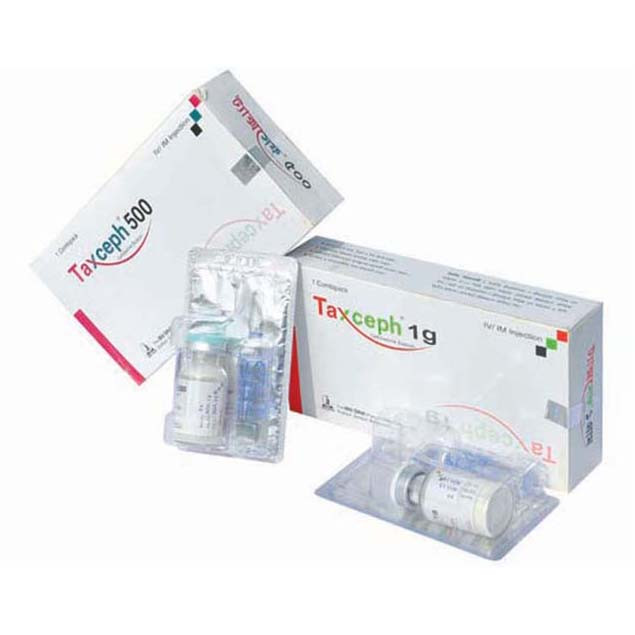500 mg vial:
৳ 76.00
Also available as:
Indications
Taxceph is indicated for the treatment of the following infections either before the infecting organism has been identified or when caused by bacteria of established sensitivity: Septicemia, Respiratory Tract Infections such as acute or chronic bronchitis, bacterial pneumonia, infected bronchiectasis, lung abscess and postoperative chest infections, Urinary Tract Infections such as acute and chronic pyelonephritis, cystitis and asymptomatic bacteriuria Soft-tissue Infection such as cellulitis, peritonitis and wound infections, Bone and Joint Infections such as osteomyelitis, septic arthritis, Obstetric and gynaecological infections: such as pelvic inflammatory disease, Gonorrhoea particularly when penicillin has failed or is unsuitable Other Bacterial Infections: meningitis and other sensitive infections suitable for parenteral antibiotic therapy.
Prophylaxis: The administration of Taxceph prophylactically may reduce the incidence of certain post operative infections in patients undergoing surgical procedures that are classified as contaminated or potentially contaminated or in clean operation where infection would have serious effects.
Prophylaxis: The administration of Taxceph prophylactically may reduce the incidence of certain post operative infections in patients undergoing surgical procedures that are classified as contaminated or potentially contaminated or in clean operation where infection would have serious effects.
Pharmacology
Cefotaxime binds to 1 or more of the penicillin binding proteins (PBPs) which inhibit the final transpeptidation step of peptidoglycan synthesis in bacterial cell wall, thus inhibiting biosynthesis and arresting cell wall assembly resulting in bacterial cell death. Cefotaxime is a broad spectrum bactericidal 3rd generation parenteral cephalosporin antibiotic. Cefotaxime is exceptionally active against gram-negative organisms sensitive or resistant to first or second generation cephalosporins. It is similar to other cephalosporins in activity against gram-positive bacteria.
Dosage & Administration
Adults: The recommended dosage for mild to moderate infections is 1 gm every 12 hourly. However, dosage may be varied according to the severity of infection, sensitivity of causative organisms and condition of the patient. In severe infections dosage may be increased up to 12 gm daily given in 3 or 4 divided doses. For infections caused by sensitive Pseudomonas spp. daily doses of greater than 6 gm will usually be required
Children: The usual dosage range is 100-150 mg/kg/day in 2 to 4 divided doses. However, in very severe infections doses of up to 200 mg/kg/day may be required.
Neonates: The recommended dosage is 50 mg/kg/day in 2 to 4 divided doses. In severe infections 150-200 mg/kg/day, in divided doses, have been given.
Dosage in gonorrhoea: 500 mg as a single dose.
Children: The usual dosage range is 100-150 mg/kg/day in 2 to 4 divided doses. However, in very severe infections doses of up to 200 mg/kg/day may be required.
Neonates: The recommended dosage is 50 mg/kg/day in 2 to 4 divided doses. In severe infections 150-200 mg/kg/day, in divided doses, have been given.
Dosage in gonorrhoea: 500 mg as a single dose.
Interaction
Increased nephrotoxicity has been reported following concomitant administration of cephalosporins and aminoglycoside antibiotics.
Contraindications
Cefotaxime is contraindicated in patients who have shown hypersensitivity to cefotaxime or the cephalosporin group of antibiotics.
Side Effects
Adverse reactions to Taxceph have occurred relatively infrequently and have generally been mild and transient. Effects reported include candidiasis, rashes, fever, transient rises in liver transaminase and/or alkaline phosphatase and diarrhoea. As with all cephalosporins, pseudomembranous colitis may rarely occur during treatment. If this occurs the drug should be stopped and specific treatment instituted.As with other cephalosporins, changes in renal function have been rarely observed with high doses of Taxceph. Administration of high doses of cephalosporins particularly in patients with renal insufficiency may result in encephalopathy. Hypersensitivity reactions have been reported, these include skin rashes, drug fever and very rarely anaphylaxis.
Pregnancy & Lactation
Although studies in animals have not shown any adverse effect on the developing foetus, the safety of Cefotaxime in human pregnancy has not been established. Consequently, Cefotaxime should not be administered during pregnancy especially during first trimester, without carefully weighing the expected benefit against possible risks. Cefotaxime is excreted in the milk.
Precautions & Warnings
Taxceph should be prescribed with caution in individuals with a history of gastrointestinal disease, particularly colitis. Because high and prolonged antibiotic concentrations can occur from usual doses in patients with transient or persistent reduction of urinary output because of renal insufficiency, the total daily dosage should be reduced when Taxceph is administered to such patients. Continued dosage should be determined by degree of renal impairment, severity of infection, and susceptibility of the causative organism. There is no clinical evidence supporting the necessity of changing the dosage of Taxceph in patients with even profound renal dysfunction.
Use in Special Populations
Dosage in renal impairment: Because of extra-renal elimination, it is only necessary to reduce the dosage of Taxceph in severe renal failure (GFR<5 ml/min = serum creatinine approximately 751 micromol/litre). After an initial loading dose of 1 gm, daily dose should be halved without change in the frequency of dosing. In all other patients, dosage may require further adjustment according to the course of infection and the general condition of the patient.
Therapeutic Class
Third generation Cephalosporins
Storage Conditions
Store below 25°C, protected from light and moisture. Use reconstituted solution immediately. Reconstituted solution is stable for up to 24 h if stored between 2° to 8°C.


